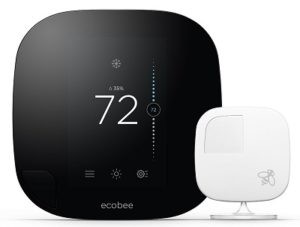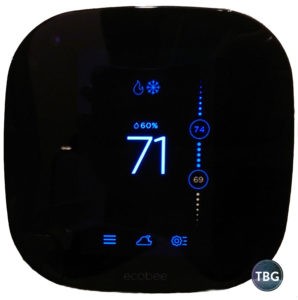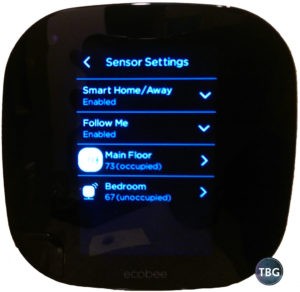Ecobee 3 Smarter Thermostat Review
Pros
Cons
Rating

Introduction
The Smart Home market has been evolving at a rapid pace, but it’s still a veritable Wild West, with plenty of startups coming and going, tales of intrigue as small players are bought up or bought out, and long-time players in the home improvement arena working hard to keep up with the newcomers. While the first area of connected home products that really took off was lighting, tech enthusiasts have long clamored for a better way to control another critical aspect of the home environment: heating and air conditioning. And while the thermostat has been around for a very long time, getting it “connected” was the first step towards truly revolutionizing the way we condition our home’s air.
That’s where upstart Ecobee and its sleek Ecobee 3 Smarter Thermostat joins the fray. You see, a handful of bigger names took the first steps of the revolution, but Ecobee is leading the second wave. We find it a bit humorous, for instance, that Google bought Nest, maker of the iconic Nest Thermostat, for $3.2 billion in January 2014, and then watched quietly as Nest proceeded to do absolutely nothing of merit ever since. Sure, the Nest thermostat is cute, but trust us, it’s no longer cutting edge, and in fact we’re not sure it ever really was, beyond its Apple-inspired styling.
So what makes the Ecobee 3 different from Nest and a whole host of other WiFi thermostats vying for your attention? Simple: the Ecobee remote sensor, one of which comes in the box with the Ecobee 3. This little contraption turns home heating and air conditioning completely on its head. Ecobee has realized that it’s so 19th century to set your home’s heating and cooling needs based on the temperature right in front of the thermostat, because if you’re like most people, you don’t live in a one-room farmhouse.
Of course, Ecobee allows you to monitor and control your home’s temperature from your phone, and will even interface with Amazon’s Echo to allow for voice control. We think these are swell features, but they aren’t what set the Ecobee 3 apart, and they aren’t enough to make a “smarter” thermostat. That’s because simply piling on additional ways to manually control your thermostat is just the tip of the iceberg, and frankly we don’t even think it’s a feature most people will use regularly.
With that introduction out of the way, let’s dive in to what makes the Ecobee so very unique, while also looking at some of the challenges Ecobee faces in making its device a must-have not just for tech enthusiasts, but for every homeowner.
Description and Features
First off, as with many startups nowadays, Ecobee has created some appealing iconography a la Apple to get people excited. While we won’t argue that the buzzing bee is indeed cute, perhaps it’s just a bit overdone. We wonder how many folks are going to be affixing the bee stickers that come in the box to their front doors, car windows, or refrigerators! Luckily, you get some other more useful items in the box, as shown below:

The most important items above are the handy extended thermostat mount that allows you to attach your Ecobee to the wall without repainting, along with the Ecobee remote sensor with stand, and finally “Power Extender Kit”, or PEK, which acts as a C-wire converter. This little box is unique as far as we know in the thermostat market, and it allows the Ecobee 3 to work with furnaces that pre-date the adoption of the common-wire standard. This common wire, which is typically blue, is used to power full-featured thermostats, and older homes likely don’t have one. As long as you’re a bit handy, you can pry open your furnace’s control panel and re-wire it with the converter box. Luckily, we didn’t have to do this, and based on our initial inspection of our furnace, we wouldn’t suggest that you do so unless you’ve tinkered with your furnace previously. It’s a nice feature to offer, nonetheless, and we applaud Ecobee for realizing that not everyone updates their furnaces quite as often as their smartphones!
By the way, in addition to interoperability with the Amazon Echo, the Ecobee 3 will also pair with the bargain-priced Wink Hub to allow for a bit more home integration. That being said, you don’t need a hub to enable smartphone controls, as Ecobee provides its own app, and our opinion is that thermostats are a bit too complicated to easily program using third-party apps like the Wink App. Again, it’s a nice feature to throw in, but we don’t suggest anyone buy the Ecobee solely for its Wink compatibility. The same goes for Apple’s Homekit, which in our opinion is more show than go, and despite Apple’s early entry into the market, likely won’t become the iTunes of this decade.
All right, let’s move on to how the Ecobee performs in real-world use, because in our opinion, it really is different from every other smart thermostat out there. Is it better? Read on to find out!

Performance
We put the Ecobee 3 to the test in an actual home and actually used it for an extended period of time to get to know all of its features. The setup was very easy, and as soon as we flipped our circuit breaker back on (don’t forget to turn it off before installation), the Ecobee 3 woke up and said hello. You can of course set up the Ecobee 3 to work like a conventional thermostat, but you’ll probably want to connect it to your home’s WiFi router, as we did, and then download the Ecobee app for iOS or Android. That being said, as we made clear on the previous page, the real magic of the Ecobee 3 isn’t in its ability to be controlled from afar, it’s in its ability to offer a totally different type of control based on multi-zone averaging. We’ll return to that subject in a minute.
First, we have to discuss one failing of the Ecobee 3, in fact the only failing we really encountered. In short, its hardware is brilliant, but its interface designers clearly tried to reinvent a wheel that didn’t need reinventing. Multiple testers tried out the Ecobee 3 once we installed it, and we were all positively flummoxed by its odd menu system. Just take a look at those silly icons at the bottom of the Ecobee screen in our photo: first you get the “hamburger” menu icon that never should have been created, but which now graces far too many websites, apps, and the like. It has no business on a thermostat, as its literal translation is simply “Menu,” and that’s not descriptive enough. In fact, the Ecobee 3 has three menus, and they overlap and intersect in completely incongruous ways. There are main functions under settings (the gear icon), settings under the main menu, and who knows what under the weather icon (which really shouldn’t have its own icon at all, as weather should be reported constantly in an used portion of the screen). Are we being a little harsh? Well, maybe, but seriously, this is clearly a case of programmers running amok to try to keep pace with brilliant hardware design. Ecobee, if you’re listening, go and play with some decades-old programmable thermostats and you’ll see why they’re so much easier to use than your product!
And in case you were expecting us to detail every menu, that’s just not what we’re going to do here. We think it’s a manufacturer’s responsibility to make their products easy to use, and we aren’t going to write a manual for the Ecobee 3. If you decide to buy one, and frankly we think anyone at least moderately interested in the Smart Home should, just call up Ecobee’s tech support (the number’s 1-877-932-6233) if you’re as puzzled by the device’s menus as all our testers were.
OK, now that we’re done with that rant, we can move on to what makes the Ecobee so incredibly ground-breaking. As you might have noticed in the photo above, our Ecobee 3 was set to keep temperatures within a range, from 69°F on the low end to 74°F on the high end. The heat or AC, respectively, would turn on if those thresholds were passed. Note that you can’t make the separation closer than 5°F, likely because you’d risk creating a perpetual on/off cycle as the furnace and AC fought each other. What’s really, really mind-blowing about this feature is that the 71°F temperature reading you see on the display is not the temperature in the room we were standing in!
Let’s consider that again for a moment, because it really takes some getting used to. The Ecobee 3 was presenting us an average temperature for our home, and would control the entire home based on that average. That means some rooms being monitored by the Ecobee 3’s sensors could drop below 69°F, while others could exceed 74°F, but the Ecobee wouldn’t turn on. Yeah, that’s a little strange isn’t it? In fact, you might be standing in front of your Ecobee thermostat thinking “my, it’s hot in here,” but the Ecobee will report a temperature that doesn’t quite match your impressions. And that’s because it’s a fictional temperature, and likely doesn’t exist in any room in your home. That’s what’s at once so mesmerizing and so confusing about the Ecobee 3’s manner of managing whole-home comfort. But overall we think it’s a good thing, and much better than setting your home’s temperature based on where the thermostat is, which likely isn’t where anyone is actually spending a lot of time (like the hallway, entryway, etc.).
Let’s turn to our sensor readings, shown below, to get a better understanding of what’s going on. Note that this menu is inexplicably found under the “gear” menu, when it frankly should be under the main menu, but we’ve been over this once already, haven’t we? Anyway, take a close look at what’s going on behind the scenes:

At this particular instance, our auxiliary bedroom sensor, which includes both a temperature probe and a motion detector, has determined that the bedroom is not occupied. That means the Ecobee 3 will set HVAC based on the temperature only at the thermostat. This again is a little confusing. Assuming you have many sensors set up, as you move from room to room, your HVAC may start and stop in ways you wouldn’t expect, as the Ecobee 3’s temperature averaging routine adds and subtracts readings from the mean. In the example here, the Ecobee would read 73°F, but as soon as someone entered the bedroom, it would read 70°F. If this is all just a bit too much to take in, you can always disable the “follow me” feature so that every sensor is included in the average at all times.
By the way, while many smart thermostats make the bold claim that they’ll save you money (perhaps enough over time to actually pay for themselves!), the Ecobee 3 really will save you money. That’s because it can accurately determine whether you are or are not at home using its multiple motion detectors. While other thermostats use gimmicky geo-fencing via their smartphone apps, which is highly unreliable in our experience, the Ecobee 3 does this all on its own. To get the most out of the system, you’ll definitely want sensors in all of your most-used rooms, but assuming you do, the Ecobee 3 will know when no one’s home and will set the HVAC to your pre-selected away status, shutting off the heat or HVAC as necessary. It’s one thing to set a schedule for your HVAC to save money, which is certainly a good start, but it’s entirely another thing for your HVAC to run only when you’re actually home.
Conclusion
In short, while the Ecobee’s color touchscreen and WiFi capability are nice, it is the Ecobee 3’s combination of whole-home temperature averaging and whole-home motion detection that allows it to run away from the field, establishing the Ecobee 3 as the only truly unique smart thermostat on the market.
The Ecobee 3 is available for $249.99 shipped from Amazon, as of our publication date, while an extra pair of room sensors goes for around $60 shipped. We believe that makes it a tremendous bargain, given the features it offers. Sure, it has the same retail price as just about every other smart thermostat out there, but because it does so much more than just connect your thermostat to the Internet, it’s the only smart thermostat we can whole-heartedly recommend.
To learn more about setting up your own Smart Home, see our Complete Guide to the Smart Home and our Smart Lighting Buyer’s Guide.


